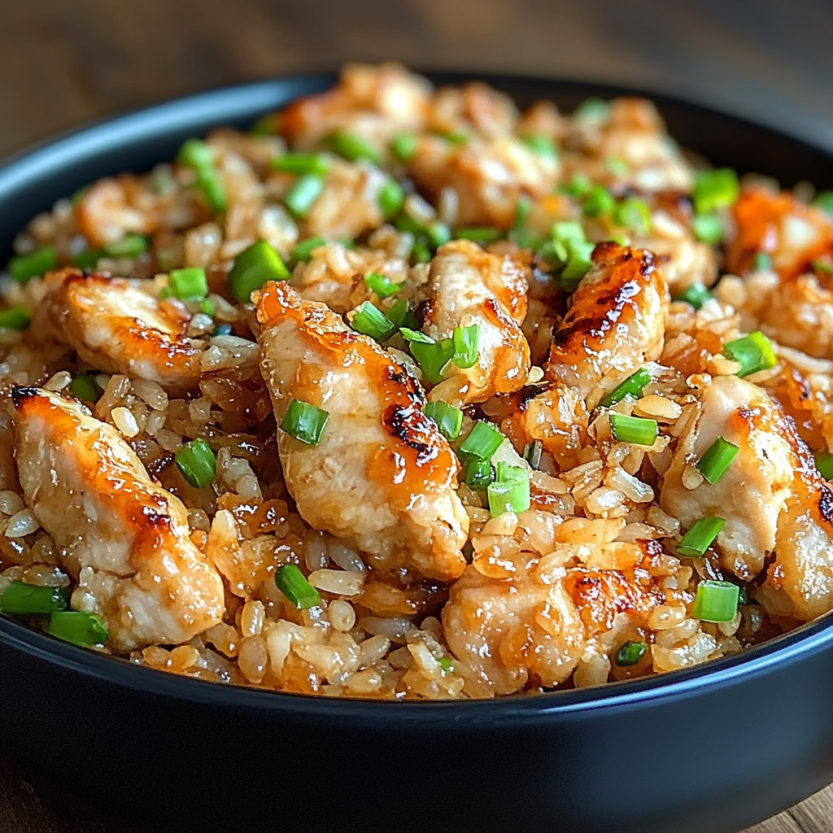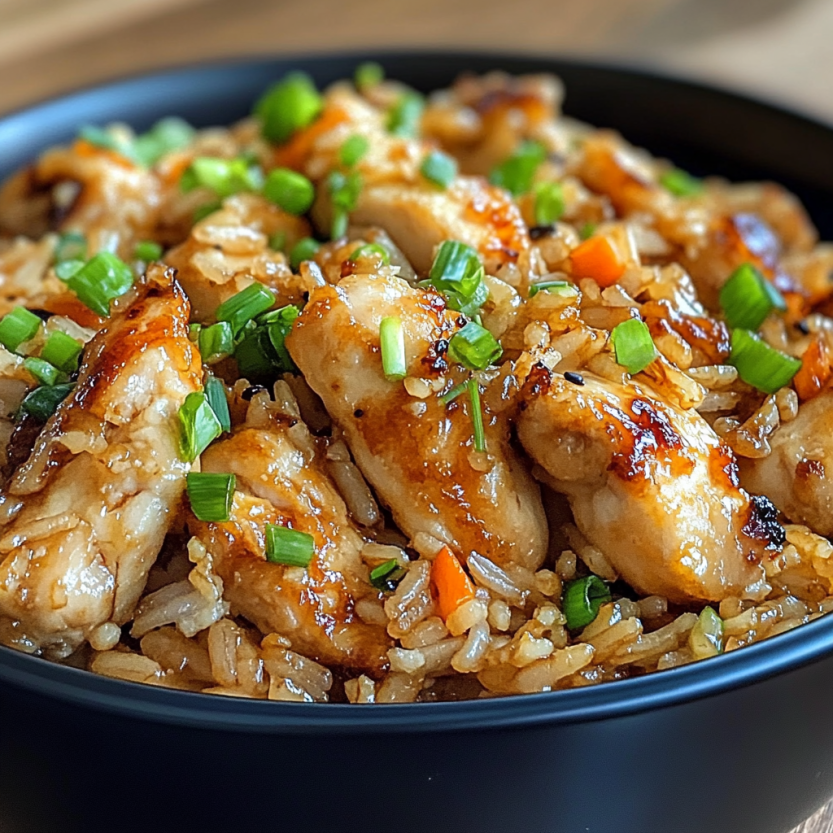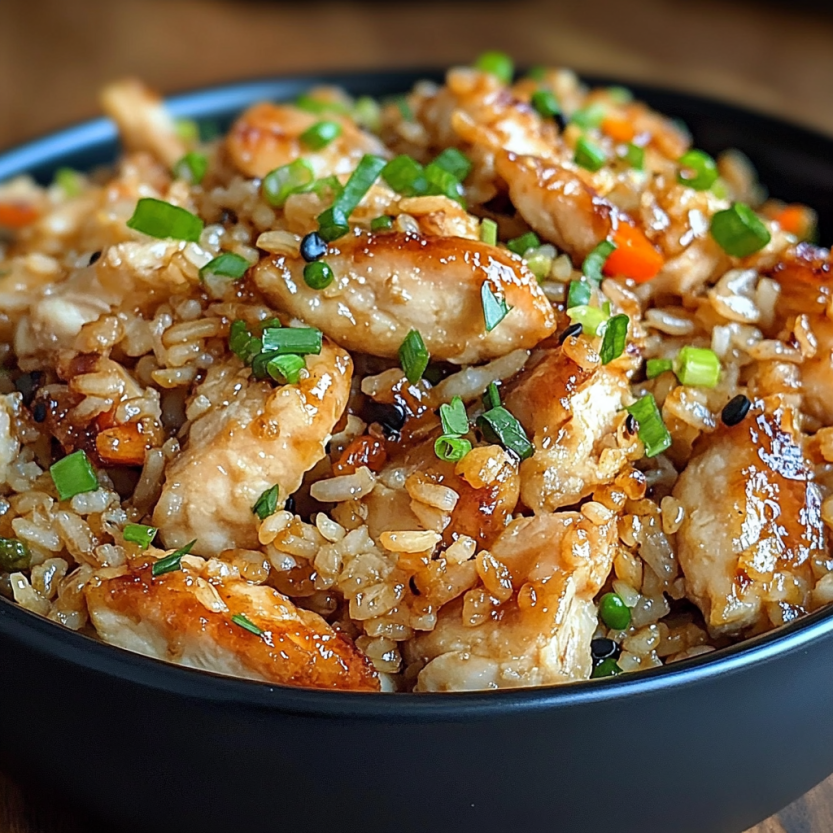 Bookmark
Bookmark
This hearty high-protein garlic chicken fried rice has become my weeknight lifesaver when I need something filling and delicious without spending hours in the kitchen. The combination of crispy chicken pieces and fluffy rice creates a satisfying meal that keeps hunger at bay for hours.
I first created this recipe during a particularly busy work week when I needed quick dinners that would fuel my evening workouts. Now it's in my regular rotation because my family requests it at least twice a month.
Ingredients
- Chicken breasts: Choose boneless skinless for the leanest option and dice into small cubes for faster cooking
- Cooked rice: Cold leftover rice works best as it creates the perfect texture and prevents mushiness
- Olive oil: Helps crisp up the chicken while adding heart-healthy fats
- Garlic: Fresh minced garlic provides the aromatic base that makes this dish sing
- Green peas: Adds color and a pop of sweetness plus extra protein and fiber
- Diced carrots: Brings natural sweetness and beautiful color contrast
- Eggs: Creates silky ribbons throughout the dish while boosting protein content
- Low-sodium soy sauce: Provides the umami foundation without overwhelming saltiness
- Sesame oil: Just a small amount adds that authentic Asian flavor profile
- Chili flakes: Completely optional but adds a pleasant heat if you enjoy spice
- Salt and pepper: Basic seasoning that enhances all the other flavors
- Fresh herbs: Optional garnish that adds brightness and color
Step-by-Step Instructions
- Cook the Chicken:
- Heat your olive oil until it shimmers in a large wok or skillet over medium-high heat. Season the diced chicken generously with salt and pepper before adding to the hot pan. Allow the chicken to develop a golden crust by resisting the urge to stir constantly. Cook for about 5-7 minutes until the outside is crispy and the inside is no longer pink. The crispy exterior adds wonderful texture contrast to the finished dish.
- Sauté Garlic:
- Remove the chicken and set aside. In the same pan with all those flavorful chicken bits, add your minced garlic. Cook for exactly one minute, stirring constantly to prevent burning. The garlic should become fragrant but not brown, as burnt garlic will impart bitterness.
- Add Veggies:
- Immediately add your peas and carrots to the garlic. The moisture from the vegetables will prevent the garlic from burning. Stir-fry for 2-3 minutes until the carrots start to soften slightly but still maintain some crunch. The vegetables should be bright and vibrant.
- Scramble the Eggs:
- Push all ingredients to one side of the pan, creating an empty space. Pour your beaten eggs into this space and let them set slightly before scrambling. As they begin to set, gradually incorporate them into the vegetable mixture. The eggs should form small, soft curds throughout the dish.
- Add Rice:
- Now comes the star ingredient. Add your cold rice to the pan, breaking up any clumps with your spatula. Cold rice separates more easily and fries better than fresh warm rice. Stir continuously for about 3 minutes, ensuring even heat distribution and that every grain gets coated with the flavors in the pan.
- Season:
- Drizzle the soy sauce and sesame oil evenly over everything in the pan. Add chili flakes if using. Toss everything together thoroughly to ensure every bite is properly seasoned. The rice should take on a light golden-brown color from the soy sauce.
- Combine Chicken:
- Return your crispy chicken to the pan and mix gently to distribute it evenly throughout the rice. Allow everything to heat through for about 2 minutes, stirring occasionally. The flavors will meld together beautifully during this final cooking stage.
- Garnish and Serve:
- Remove from heat and top with freshly chopped green onions or parsley if desired. The fresh herbs add brightness to contrast with the savory, umami-rich dish. Serve immediately while hot.
 Bookmark
Bookmark
The sesame oil is my secret weapon in this recipe. Though it's just a small amount, it transforms the entire dish with its nutty aroma and distinctive flavor. The first time I made this for my partner, he immediately asked what made it taste "so authentic" compared to my previous fried rice attempts. That tiny teaspoon of sesame oil made all the difference.
Storage and Meal Prep
This chicken fried rice stays delicious in the refrigerator for up to 4 days when stored in an airtight container. The flavors actually intensify slightly overnight, making it even more delicious the next day. For meal prep, I portion it into individual containers for grab-and-go lunches throughout the week.
When reheating, sprinkle a few drops of water over the rice before microwaving to restore moisture. Alternatively, reheating in a skillet works wonderfully to restore some of the crispy texture. Just add a small splash of soy sauce if it seems dry.
Smart Substitutions
This recipe welcomes customization based on what you have available. Here are some tried-and-true variations I've successfully made:
- Brown rice can replace white rice for additional fiber and nutrients without sacrificing flavor. Just note that brown rice has a slightly chewier texture.
- Turkey, shrimp, or tofu can substitute for chicken based on your preferences or what you have on hand. With tofu, I recommend pressing it first and cooking until very crispy.
- Frozen mixed vegetables work perfectly when fresh options are limited. Simply add them directly to the pan without thawing first.
- For a lower-carb version, cauliflower rice makes an excellent substitute for traditional rice. Reduce the cooking time slightly as cauliflower rice cooks faster than grain rice.
Serving Suggestions
This protein-packed fried rice works beautifully as a standalone meal, but I sometimes serve it with sides to create a more elaborate dining experience. A simple cucumber salad with rice vinegar dressing provides a refreshing contrast to the savory rice.
For a more substantial feast, pair with vegetable spring rolls or a clear broth soup like egg drop or miso. The light soup balances the hearty rice dish perfectly.
I also love serving this with a drizzle of sriracha or chili oil on top for those who appreciate extra heat, alongside a sprinkle of toasted sesame seeds for additional texture and visual appeal.
 Bookmark
Bookmark
Frequently Asked Questions About Recipes
- → Why should I use cold rice for fried rice?
Cold rice works best because it's drier and the grains remain separate when stir-fried. Freshly cooked rice contains more moisture and tends to clump together, resulting in soggy fried rice. For best results, cook your rice a day ahead and refrigerate it overnight, or spread freshly cooked rice on a baking sheet to cool quickly before using.
- → Can I substitute the protein in this dish?
Absolutely! While chicken provides excellent protein content, you can substitute with tofu, shrimp, beef, or even more eggs for vegetarian options. For tofu, press it first to remove excess moisture and crisp it up in the pan before proceeding with the recipe. Adjust cooking times accordingly for different proteins.
- → How can I meal prep this dish?
This stir-fry is perfect for meal prep. Cook a large batch and portion it into airtight containers. It keeps well in the refrigerator for 3-4 days. For best results when reheating, add a splash of water before microwaving to prevent dryness, or reheat in a skillet with a little oil to maintain the crispy texture.
- → What vegetables can I add to this stir-fry?
This dish is versatile and works well with many vegetables. Consider adding bell peppers, broccoli florets, snap peas, corn kernels, mushrooms, bean sprouts, or diced zucchini. For leafy greens like spinach or bok choy, add them at the very end of cooking as they wilt quickly.
- → How can I make this dish lower in sodium?
To reduce sodium content, use low-sodium soy sauce as specified in the recipe, or substitute with coconut aminos which naturally contain less sodium. You can also reduce the total amount of soy sauce and increase flavor with fresh herbs, ginger, garlic, and a squeeze of lime juice instead.
- → What's the best type of rice to use?
Medium to long-grain white rice like jasmine or basmati works best for fried rice as they remain fluffy and separate when cooked. Brown rice can be used for added nutrition but may result in a chewier texture. Avoid short-grain or sticky rice varieties as they tend to clump together during stir-frying.
